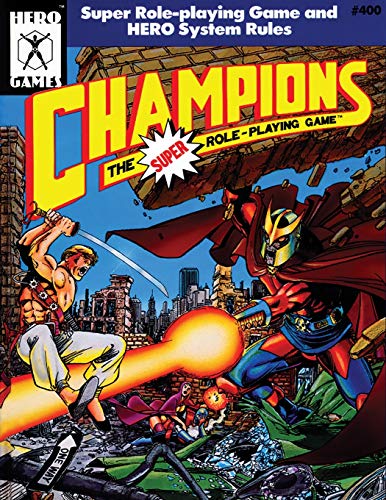I started to feel that I didn’t know roleplaying games well enough so I came up with the plan to read a roleplaying game corebook for every year they have been published. Selection criteria is whatever I find interesting.

Champions is a classic superhero roleplaying game I read in the 4th edition published in 1989. The 4th edition is somewhat unusual in that instead of one book book with consecutively numbered pages, it’s set up like a collection of three separate books under one set of covers. One is the HERO system rules that Champions uses, the second discusses Champions specifically and the third is adventures and characters.
There are two different approaches to designing monsters, enemies, superpowers and all kinds of game elements that interact mechanically with each other during play. One is the method used in D&D 5th Edition where spells or monsters are individual setting elements. A character and a player will both understand Magic Missile as a discrete, specific thing the use of which has certain effects and connotations.
The other method is to systematize all these elements, creating an underlying design structure. This is the method used in D&D 3rd Edition. It tends to feature things like tags and templates that can be remixed, added and modified to create new versions of existing setting elements. While often pleasing to a top-level sense of order and system, it tends to distance the systemic layer of the game from the fiction and character-level understanding of what’s what.
Champions is an exemplar of the second method. It has a powerful, extremely detailed systemic framework for superpowers and character creation. You don’t pick a power like “avalanche”. Instead, you consider what such a power would mean in systemic terms and then model it using abstract characteristics such as “energy blast”. There are meta-level powers such as “multipower” that exist only so that you can minutely design the function of your superhuman abilities in a specific game mechanical way.
Another design distinction concerns the role of player and GM skill. The current contemporary design ethos downplays participant skill, so the goal is to create systems that produce the right kind of play while compensating for lack of skill. Champions represents the opposite design strategy where the user is assumed to be fundamentally skilled and thus capable of making their own design choices as to what kind of a game they want to play. The game’s function is to support and help this assumed skilled user.
(Like most roleplaying games, Champions has pretensions to being somehow beginner friendly. It’s not.)
For example, the game features a system where some powers are marked with warning signs because they’re potentially game-breaking. Their use is left to the discretion of the GM and the players. If they want to risk having player characters with time travel, they can. This kind of design is unfashionable now but entirely internally coherent in the values it upholds.
I found Champions to be an extremely well designed game for simulation-heavy, system oriented play. It’s not my style at all but feels like the pinnacle of a design ideal.
I like the ideas, views, and opinions that you present in your blog. In general and in this exact blog entry. I appreciate the love and the passion You present towards the RPGs. It’s sooo cool that You can see the quality even in those games You don’t find as your cup of tea.
” It’s not my style at all but feels like the pinnacle of a design ideal”, is very well put. And gotta affirm that this game is THE pinnacle of a design ideal. It is a Classic for a Reason.
Thanks for reviewing this Great RPG Gem!